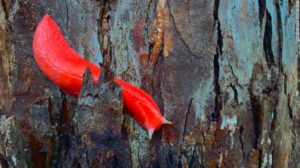
Extremely Rare Fluorescent Pink Slug Survives Australian Bushfires
The extremely rare fluorescent pink slug, which is unique to Mount Kaputar in New South Wales, managed to survive the harsh bushfires in Australia by hiding into rock cervices.
The pink slug, which is only found in the mountaintop in NSW, managed to survive the bushfires that burnt through much of its alpine habitat.
In a post that was made by the New South Wales National Parks and Wildlife Service, they said, “In positive news, the eye-catching bright pink Mount Kaputar slug has survived the recent bushfires, with about 60 spotted by NPWS rangers after recent rainfall in Mount Kaputar National Park.”
The post added, “There had been fears for this unusual species after fire impacted much of its alpine habitat. They may not be as cute as koalas or wallabies, but this species also plays an important role in its ecosystem. The park currently remains closed to visitors due to fire damage.”
In positive news, the eye-catching bright pink Mount Kaputar slug has survived the recent bushfires, with about 60…
Posted by NSW National Parks and Wildlife Service on Saturday, 25 January 2020
According to reports, around 60 brightly colored Mount Kaputar Pink Slugs were spotted by the National Parks and Wildlife Service Rangers after the recent rainfall in Mount Kaputar National Park.
The slugs can grow to size longer than a human hand.
The Kaputar Fire burnt through the area for more than 6 weeks from October to December 2019.
The fire damaged over 18,000 hectares of land.
The mountain is home to at least 20 species of snails and slugs that are nowhere to be found in any part of the world.
The area is also a designated endangered ecological community, the first type of community in Australia.
Some of the fluorescent slugs managed to survive the bushfires because they retreated into their rock crevices.
Frank Kohler, a malacologist at the Australian Museum, said around 90 percent of the slug population has been killed in the fires.
Is it a leaf? …No… Is it bark?…No… It's Pinky!!! Mt Kaputar pink slug @AustmusResearch @austmus pic.twitter.com/nMaJtlVLmN
— Anja Divljan (@AnjaDivljan) November 13, 2015
Slugs eat fungi, mold, and moss, which are believed to have been burnt by the fire.
Experts are believed to recover quickly in the upcoming months.
In the upcoming months, the slug population in the mountain is at risk of being seen more easily by hungry birds due to their bright color.
Kohler said the slug is a “poster boy for snails and slugs” because of its distinctive color.
Kohler added, “But it comes with a number of other species that are similarly threatened by the fires that don’t get the same attention.”
The Mount Kaputar ecological community includes 3 species of the carnivorous snails that are nowhere to be found in the world.
According to reports, the Mount Kaputar Slug may take around 5 years to recover from the fires, and the snails could take at least 20 years.